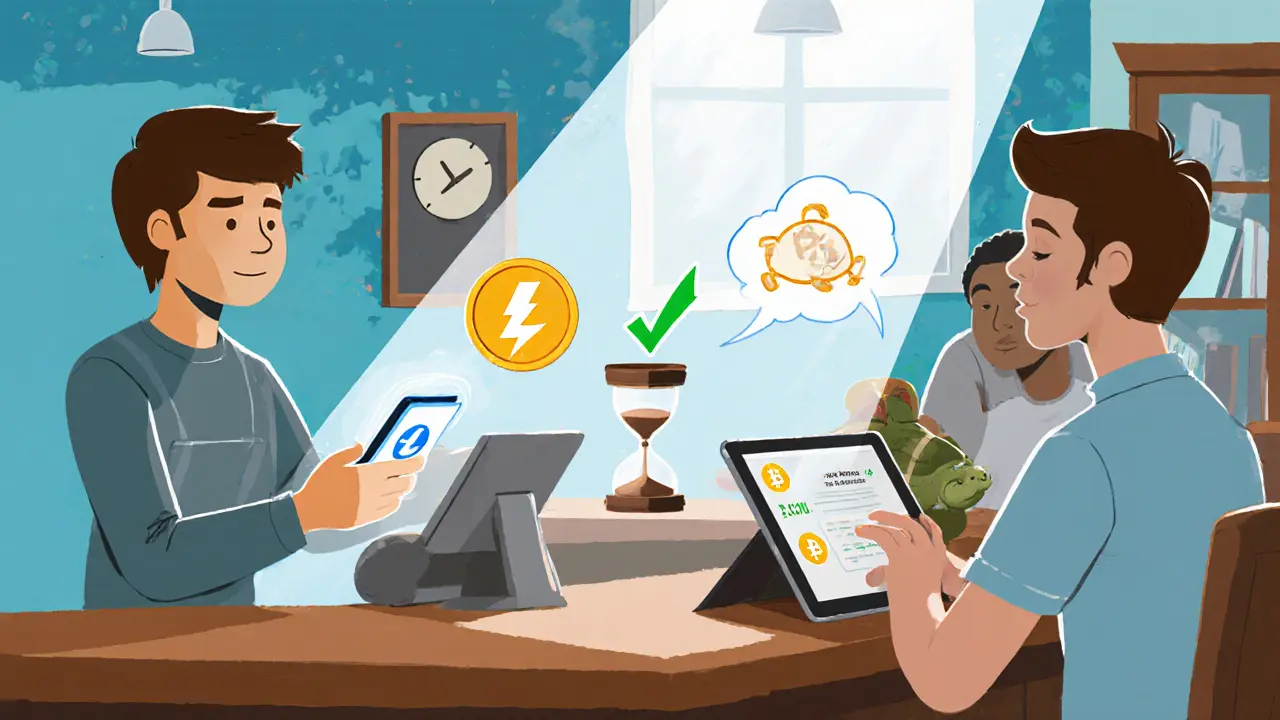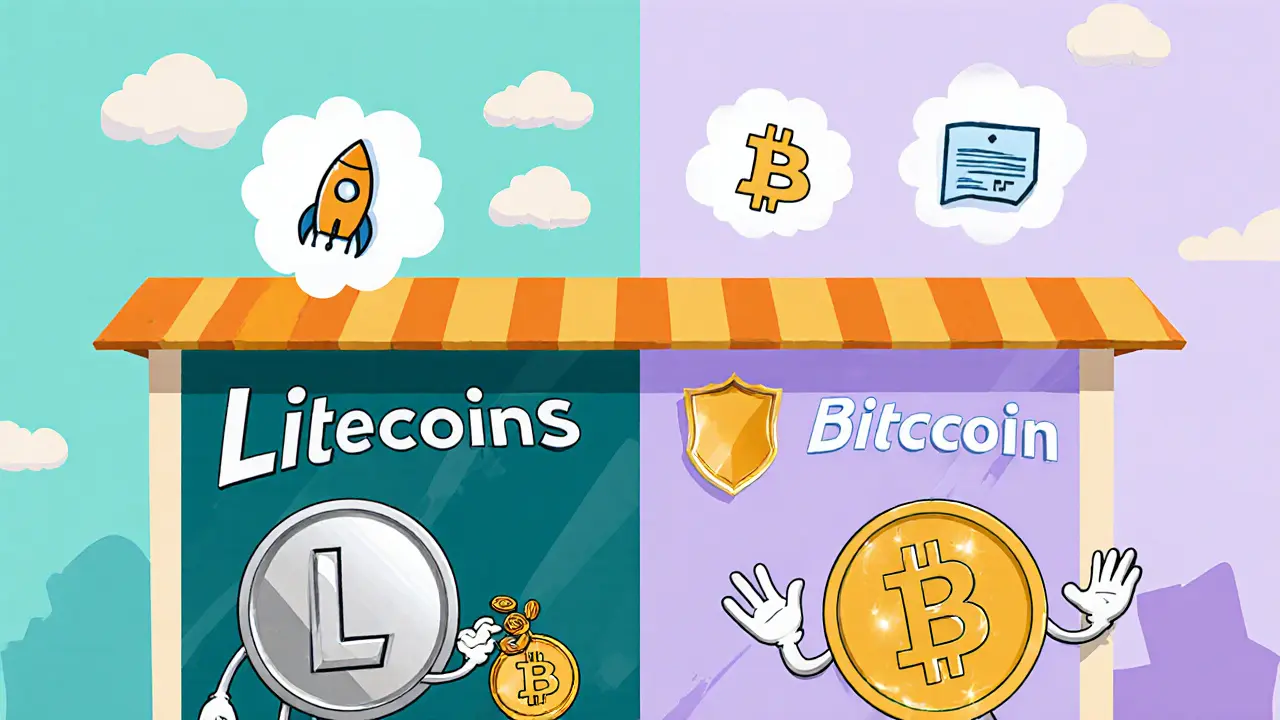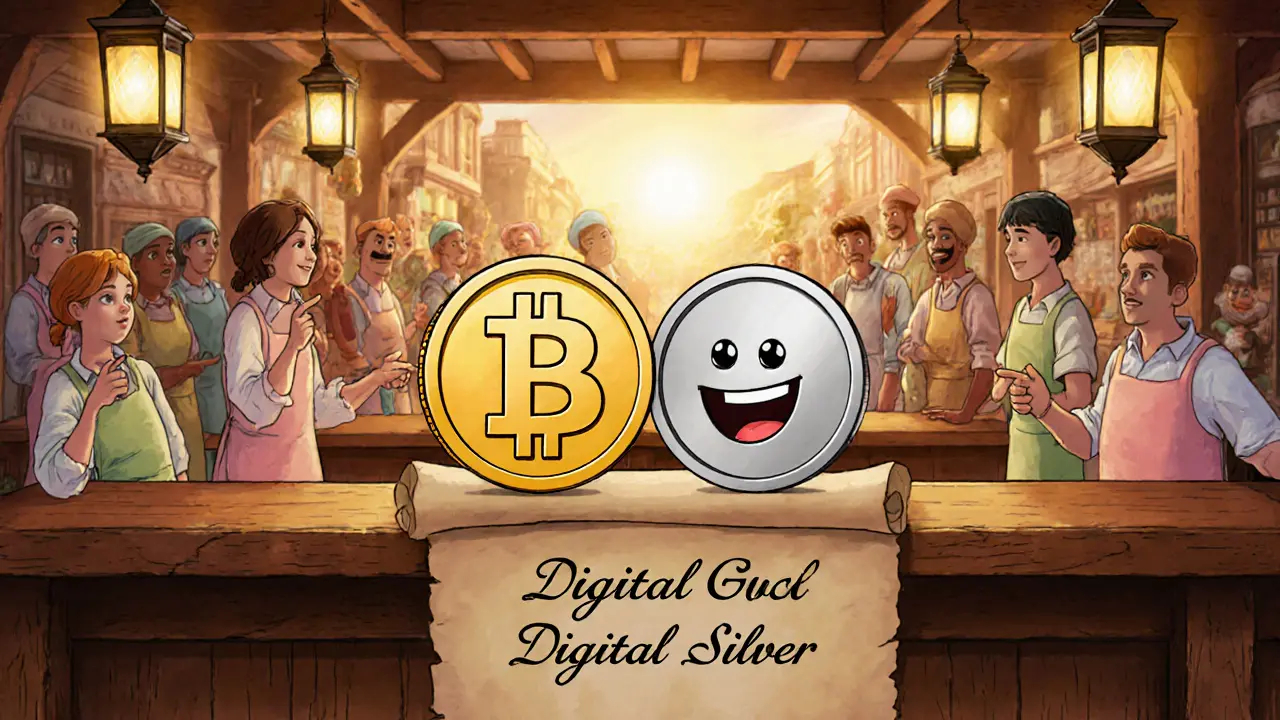Litecoin vs Bitcoin Payment Calculator
Compare Payment Costs
Calculate real transaction costs for Litecoin vs Bitcoin based on your payment amount. See fee differences and confirmation times.
Litecoin (LTC)
Total Cost
Includes transaction fee
Bitcoin (BTC)
Total Cost
Includes transaction fee
Key Takeaways
- Litecoin confirms transactions in 5‑7 minutes on average, while Bitcoin needs 30‑60 minutes without Layer 2.
- Average on‑chain fee: Litecoin ≈ $0.04, Bitcoin ≈ $1.35.
- Litecoin processes 1‑2 TPS on‑chain; Bitcoin peaks at 7 TPS but Lightning pushes it over 1,000 TPS.
- Merchant acceptance: Bitcoin 82 % of major e‑commerce platforms, Litecoin 37 %.
- Security gap: Bitcoin’s hash rate ~400 EH/s vs Litecoin’s ~2.7 PH/s.
When you’re picking a crypto for everyday payments, the debate usually lands on two familiar names: Litecoin is a peer‑to‑peer digital currency launched in 2011 that aims to be the "digital silver" to Bitcoin’s "digital gold". Bitcoin was the first cryptocurrency, introduced in 2009, and is widely regarded as a store of value. Both run on proof‑of‑work blockchains, but their design choices lead to very different payment experiences.
Technical Foundations: How the Protocols Differ
At the core, the two networks share a similar architecture, yet key parameters diverge.
- Block time is the average interval between new blocks; Litecoin’s is 2.5 minutes, Bitcoin’s is 10 minutes.
- Transaction throughput: Litecoin typically handles 1‑2 transactions per second (TPS) on‑chain, while Bitcoin’s theoretical maximum is about 7 TPS.
- Mining algorithm: Litecoin uses Scrypt a memory‑hard hash function that originally allowed GPU/CPU mining. Bitcoin relies on SHA‑256 a compute‑intensive algorithm now dominated by ASIC miners.
- Network security: Bitcoin’s hash rate sits near 400 exahash per second (EH/s); Litecoin trails at roughly 2.7 petahash per second (PH/s).
These differences shape the cost and speed of payments.
Transaction Fees: Why Litecoin Is Cheaper
Fees are a make‑or‑break factor for merchants. In 2025, the average on‑chain fee for Bitcoin hovered around $1.37 per transaction, according to Ainvest’s October‑2024 analysis. Litecoin’s fee consistently stayed under $0.05, based on CoinRemitter’s Q1‑2025 data. The fee gap stems from Litecoin’s faster block time and lower congestion, meaning users rarely need to out‑bid each other for block space.
For micro‑payments-think buying a coffee or a digital sticker-the difference is stark. A $3 coffee paid with Bitcoin costs roughly $4.37 total, whereas the same purchase with Litecoin adds barely a penny.
Confirmation Speed: From Wallet to Store Front
Merchants typically wait for a few confirmations before considering a payment final. Bitcoin generally requires 3‑6 blocks, translating to 30‑60 minutes. Litecoin’s 2.5‑minute blocks cut that window to 5‑7.5 minutes after 2‑3 confirmations, as measured by ChangeHero’s February‑2025 study.
Lightning Network narrows the gap dramatically for Bitcoin, delivering sub‑second payments on‑chain. However, Lightning adds complexity: users must open channels, manage liquidity, and trust third‑party custodians. Litecoin processes fast, low‑fee payments directly on its base layer, which many small businesses prefer for its simplicity.

Merchant Adoption: Where the Coins Live
Adoption rates reveal market sentiment. CoinRemitter’s 2025 survey showed 82 % of major e‑commerce platforms accept Bitcoin, while 37 % support Litecoin. The gap narrows among niche retailers and point‑of‑sale (POS) systems that value speed. For example, NOWPayments gave Litecoin a 4.6/5 rating for payment speed, based on 1,247 reviews, while Bitcoin’s overall rating sat at 4.3/5 due to higher fees despite broader brand recognition.
Implementation time also matters. CoinRemitter’s merchant guide notes that integrating Litecoin takes 15‑20 minutes of setup, whereas Bitcoin’s integration-especially with Lightning-often stretches to 25‑30 minutes.
Use‑Case Spotlight: Microtransactions & Cross‑Border Payments
Litecoin shines in two areas:
- Microtransactions: With near‑zero fees and quick confirmations, Litecoin processed $12.75 billion in daily volume during Q1‑2025, most of it retail‑focused.
- Cross‑border remittances: Swapin’s 2025 benchmark found Litecoin’s international transfers cost 87 % less and settle 68 % faster than Bitcoin’s on‑chain transfers.
Bitcoin, meanwhile, dominates high‑value institutional flows and benefits from a robust ecosystem of Layer 2 solutions. The Lightning Network’s Q2‑2025 metrics show 1,200 TPS, enough for large‑scale retail if the infrastructure is in place.
Future Developments: What’s Next for Payments?
Both networks have roadmaps that could shift the balance.
- Bitcoin: Taproot Upgrade 2.0 slated for Q3‑2025 aims to make Lightning channel openings 40 % faster.
- Litecoin: A MimbleWimble privacy extension activated in Q4‑2024 adds optional anonymity but reduces throughput by about 15 %.
- Regulatory outlook: The SEC classifies Bitcoin as a commodity, while Litecoin falls under a “payment token” category, potentially easing compliance for payment processors.
- Potential ETFs: A Litecoin spot ETF expected Q4‑2025 could boost merchant confidence and drive broader acceptance.
In short, Bitcoin’s future payment growth hinges on Layer 2 adoption, while Litecoin’s path is about widening its base‑layer niche.

Side‑by‑Side Comparison
| Metric | Litecoin (LTC) | Bitcoin (BTC) |
|---|---|---|
| Block time | 2.5 minutes | 10 minutes |
| Avg. TPS (on‑chain) | 1‑2 | ~7 (theoretical) |
| Avg. fee (USD) | ≈ $0.04 | ≈ $1.37 |
| Typical confirmation time for merchants | 5‑7 minutes (2‑3 confirmations) | 30‑60 minutes (3‑6 confirmations) |
| Market cap (Oct 2025) | $6.9 billion | $1.2 trillion |
| Hash rate | ~2.7 PH/s | ~400 EH/s |
| Merchant acceptance (major platforms) | 37 % | 82 % |
| Daily retail transaction volume | $12.75 billion (83 % retail) | $18.7 billion (12 % retail) |
Choosing the Right Coin for Your Business
Consider three dimensions:
- Speed vs. Brand: If you need instant confirmations and ultra‑low fees, Litecoin is the clear pick. If your customers already trust Bitcoin’s brand, you may accept the higher fee.
- Infrastructure: Do you have the technical ability to manage Lightning nodes? If not, Litecoin’s simple on‑chain flow is easier.
- Regulatory Fit: Litecoin’s payment‑token status can simplify KYC/AML processes in some jurisdictions.
Many merchants adopt a dual‑acceptance model: Bitcoin for brand‑aware shoppers and Litecoin for fast, cheap checkout.
Frequently Asked Questions
Is Litecoin really faster than Bitcoin for everyday purchases?
Yes. Litecoin’s 2.5‑minute block time means a payment is usually confirmed within 5‑7 minutes, while Bitcoin often needs 30‑60 minutes without Lightning.
Do I need special hardware to accept Litecoin?
No special hardware is required. Most payment processors (CoinRemitter, NOWPayments) let you plug in an API key and start accepting LTC in under 20 minutes.
How do transaction fees compare in real‑world scenarios?
A $10 purchase costs about $10.04 with Litecoin, versus roughly $11.37 with Bitcoin on the base layer. Lightning can bring Bitcoin fees down to pennies, but that adds setup steps.
Is Litecoin secure enough for high‑value payments?
Litecoin’s hash rate is far lower than Bitcoin’s, making it theoretically less secure against 51 % attacks. However, its network has never been compromised, and the lower value per coin reduces the incentive for large attacks.
Will future upgrades change this comparison?
Bitcoin’s Taproot 2.0 and Lightning improvements aim to close the speed gap, while Litecoin’s upcoming spot ETF could boost merchant confidence. Both ecosystems continue evolving, so keep an eye on roadmap releases.
Bottom line: If you value instant confirmation and tiny fees, Litecoin vs Bitcoin payments tilts in Litecoin’s favor for most everyday transactions. If brand trust and broader acceptance matter more, Bitcoin still leads the pack. The safest play for most businesses is to support both and let the shopper decide.


Comments
Jenna Em
Every time we chase the shiniest coin, we forget that the real power lives in the quiet ones. Litecoin feels like the hidden messenger that the elites don’t want us to notice. Its speed and low fees could be the tool they use to move money under the radar, away from the Bitcoin spotlight. If you think it’s just another altcoin, you might be missing the bigger picture of how the system keeps us divided.
October 20, 2025 AT 09:37